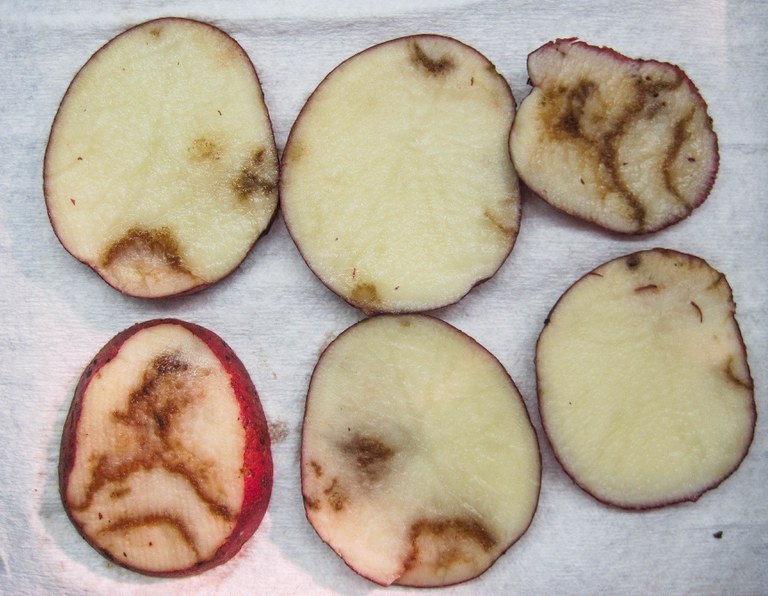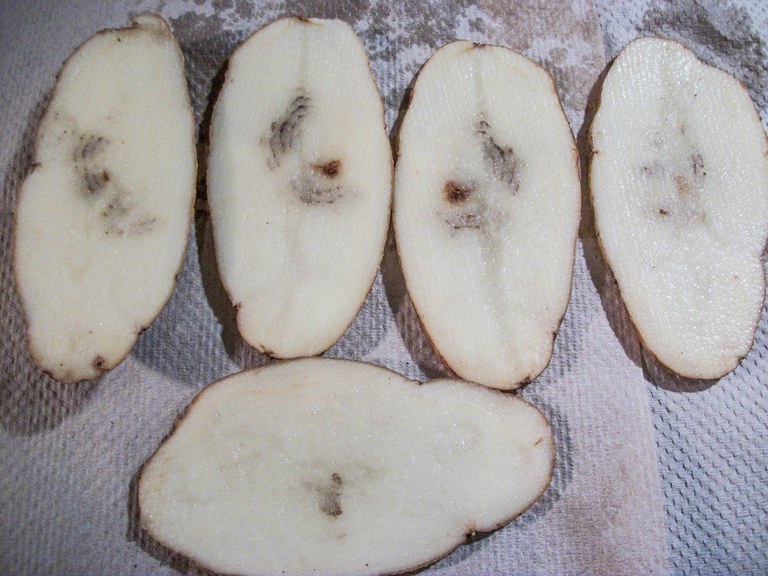Potato Tuber Viruses: Mop-top Management (A1777, Revised Sept. 2018)
Availability: Web only
The potato mop-top virus (PMTV) is spreading throughout the potato-growing regions in the U.S. This viral disease was confirmed in Maine (2003), North Dakota (2010), Washington (2011), Idaho (2013), New Mexico (2015) and Colorado (2015). It also is found in production areas of Europe, South America and Asia.
Potato mop-top virus is seed- and soil-borne, and vectored by Spongospora subterranea f. sp. subterranea. It is the causal agent of powdery scab on potato.
Once established in fields, powdery scab can survive for up to 18 years in the absence of a potato crop. Potato mop-top virus is of economic importance to potato growers throughout the U.S. because it may affect tuber quality and may be transferred from seed to daughter tubers.
The potato mop-top virus is restricted primarily to the Solanaceae and Chenopodiaceae families. In addition to infested fields, PMTV has many other potential hosts, such as eastern black nightshade (Solanum ptycanthum), hairy nightshade (Solanum physalifolium), common lambsquarters (Chenpodium album) and sugar beets (Beta vulgaris).

Figure 1. Tuber flesh exhibiting arcs, streaks and/or flecks when infected with mop-top virus. Flesh also may become rust-colored or tinged with brown. (Owusu Domfeh)

Figure 2. Tuber flesh infected with potato mop-top virus expresses arcs and streaks, often referred to as “spraing.” (Owusu Domfeh)
PMTV Symptoms
Reported PMTV symptoms on potatoes include yellowing of leaves and shortened internodes, resulting in stunted growth, hence the name “mop-top.” What is more concerning than foliar damage is that tuber quality can be compromised. The primary infection on tubers may be expressed as arcs or rings on the tuber surface.
Secondary infection of PMTV may include the primary symptoms and/or tubers may have deep cracking, a network of cracking or distortions to the skin that appear as blotchy surface markings. Symptoms vary widely by cultivar sensitivity to PMTV.
Potato mop-top virus generally is not passed to all tubers of an infected potato plant. Producers need to take care not to infest fields with PMTV from known powdery scab- and PMTV-infected fields and to avoid PMTV or powdery scab-infected seed tubers.
Recent research work examined 63 cultivars and their sensitivity to PMTV (Table 1). Most russet-skinned cultivars were insensitive to PMTV (less than 5 percent PMTV incidence), with the exception of Alpine Russet and the selection POR06V12-3. The red-, yellow- and white-skinned cultivars evaluated ranged from insensitive to sensitive (greater than 15 percent PMTV incidence). Choosing a tolerant cultivar is very important in areas known to have powdery scab or PMTV.

Managing the Virus
Managing PMTV is difficult. No tests for the virus are required in the U.S. seed certification regulations to regulate PMTV. The most effective way to protect potato production is by selecting cultivars that possess tolerance to PMTV tuber necrosis. No commercially available potato cultivars are completely resistant to PMTV.
Here are potato mop-top management recommendations:
• Abandon infested fields and never plant potatoes in them again.
• Remove all soil from implements that move from infested fields to noninfested fields (maintain the same practice for equipment used in producing rotational crops and any tillage implements).
• Do not respread harvest soil into noninfested fields.
• Ensure seed sources are produced in fields free of powdery scab and/or PMTV through polymerase chain reaction (PCR) testing and/or bioassay.
• Plant potato cultivars that do not express tuber necrosis symptoms.
Selected References
Calvert, E.L., and B.D. Harrison. 1966. Potato mop-top, a soil borne virus. Plant Pathology 15:31-40.Domfeh, O., F.G. Bittara and N.C. Gudmestad. 2015. Sensitivity of potato cultivars to Potato mop-top virus-induced tuber necrosis. Plant Disease.
Johnson, S.B. Potato mop-top virus (PMTV). University of Main Co-operative Extension Bulletin 2437. 2008.
Yellareddygari, S.K.R., J.L. Whitworth and N.C. Gudmestad, 2018. Assessing potato cultivar sensitivity to tuber necrosis caused by Potato mop-top virus. Plant Disease. 102:1148-1153.

September 2018

